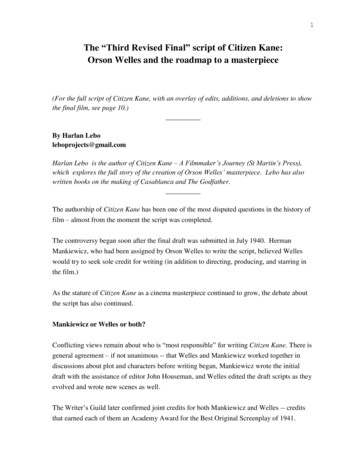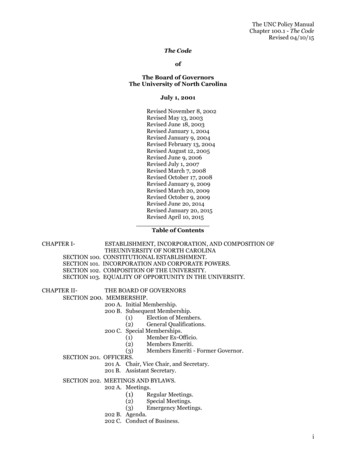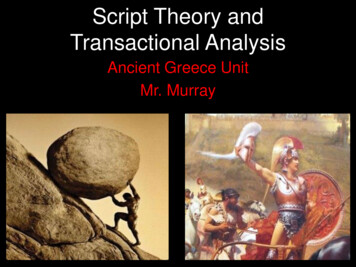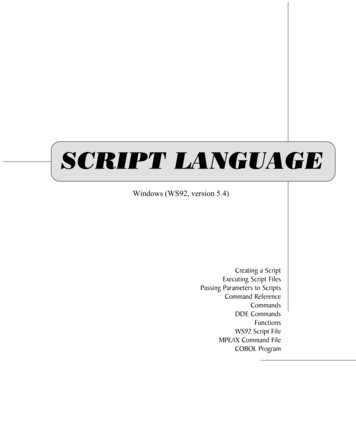
Transcription
1The “Third Revised Final” script of Citizen Kane:Orson Welles and the roadmap to a masterpiece(For the full script of Citizen Kane, with an overlay of edits, additions, and deletions to showthe final film, see page 10.)By Harlan Leboleboprojects@gmail.comHarlan Lebo is the author of Citizen Kane – A Filmmaker’s Journey (St Martin’s Press),which explores the full story of the creation of Orson Welles’ masterpiece. Lebo has alsowritten books on the making of Casablanca and The Godfather.The authorship of Citizen Kane has been one of the most disputed questions in the history offilm – almost from the moment the script was completed.The controversy began soon after the final draft was submitted in July 1940. HermanMankiewicz, who had been assigned by Orson Welles to write the script, believed Welleswould try to seek sole credit for writing (in addition to directing, producing, and starring inthe film.)As the stature of Citizen Kane as a cinema masterpiece continued to grow, the debate aboutthe script has also continued.Mankiewicz or Welles or both?Conflicting views remain about who is “most responsible” for writing Citizen Kane. There isgeneral agreement – if not unanimous -- that Welles and Mankiewicz worked together indiscussions about plot and characters before writing began, Mankiewicz wrote the initialdraft with the assistance of editor John Houseman, and Welles edited the draft scripts as theyevolved and wrote new scenes as well.The Writer’s Guild later confirmed joint credits for both Mankiewicz and Welles -- creditsthat earned each of them an Academy Award for the Best Original Screenplay of 1941.
2The real question remains.Regardless of who wrote the draft scripts for Citizen Kane, the discussion misses a larger andmore important issue: The final film of Citizen Kane is significantly different from any of thescripts prepared before production of the film began.Between February and July 1940, seven official draft scripts were produced – each dated andcopied on RKO stationery for use by the production team. The script designated “Final” wasreleased on June 18, 1940. The “Second Revised Final” was distributed on July 9. The“Third Revised Final” – the last formal script – was released on July 16.In addition, an unusual “Correction Script” – undated, typed on plain paper, and arranged in anote-like format -- was produced at an unknown time after July 16 (more on the “CorrectionScript” later).All of the script drafts – even the Third Revised Final and the Correction Script – contain alarge amount of superfluous material, and several major scenes lack focus on the topics thatwould eventually become the core of Welles’ vision for the final film (for examples, see #2below).But more important: several key scenes in the final film are not part of the Third RevisedFinal script – the last draft that was completed before Mankiewicz left the project on July 27and not long before the official shooting schedule began on July 30, 1940 (a few shots hadbeen completed earlier).Welles at a crossroadsAfter filming began, Welles still had to deal with several lingering issues in the script thathad not been resolved.Earlier in 1940, script cuts had been ordered because of budget restrictions. As a result, bythe time Kane is shown as a young man for the first time in the Third Revised Final script -what would have been more than 20 minutes into the film if shot as written -- viewers wouldhave known little about Kane’s character early in his adult life.
3And key scenes had not been written yet that Welles believed were needed so viewers wouldappreciate Kane as a crusading public servant and an unscrupulous publisher. Welles alsowanted to show how the Depression destroyed Kane’s empire (see #9).Of particular importance to Welles, the Third Revised Final script still contained scenes thatshow Kane trying to explain his own behavior – an issue that Welles would address not onlyfor Citizen Kane, but in his subsequent films as well (see #1).The story of how Welles modified the script during production is explored in detail in mybook, Citizen Kane: A Filmmaker’s Journey. But in brief, here is how Welles continued hiswork on the script, and what this process accomplished.Rewriting and more rewritingAs filming proceeded in August 1940, and with gaps remaining and several sections of thescript still not as Welles wanted them, Welles’ writing continued throughout the shootingschedule. Welles’ assistant Kathryn Trosper recalled taking dictation for script additions asearly as 2 a.m. while Welles was in extended makeup sessions.Associate producer Richard Baer also recalled a frenetic pace to the rewriting: “It is notpossible,” Baer said years later, “to fix the actual number of complete redrafts by Welles, aschanges were being continuously made on portions that had previously been written.”How did Citizen Kane change in Welles’ revisions and additions to the script?Unfortunately, no examples of scripts for these late scenes still exist, and Welles neverdescribed precisely how he prepared and shot those scenes. The “Correction Script” includessome of Welles’ edits, but none of the additions that were still to come. And no records existthat explain the role of the “Correction Script” in the production.As an alternative to first-hand historical evidence, this document explores the creation ofCitizen Kane as shown through an overlay on top of the Third Revised Final script that showsWelles’ edits, deletions, and additions as filming proceeded.Editing “final” scripts is routine in filmmaking, but Welles’ revisions to the Third RevisedFinal script for Citizen Kane were extensive; as you will see in this document, Welles’ work
4changed almost every scene, sometimes through edits and tightening of dialogue, or bydeleting material he saw as unnecessary, or by inserting entirely new text and full scenes.Welles probably produced his final edits of the script and the new scenes by working as hehad done during the production of his plays on Broadway: writing literally at the last minute– possibly working directly with actors on the set.“Orson created much of the film on the fly,” said Trosper. “If a shot didn’t work, Orsonchanged it on the set. If an actor came up with a better line, he used it.”For the new scenes, it is likely that all of them were written by Welles late in production, asevidenced by the sudden burst of budget requests beginning in September 1940 – more than amonth after filming began -- for new sets and extended contracts for several actors.Edits, additions, and deletionsThis introduction to the script will be expanded into an article in 2021 that will include moredetails about how Welles’ revisions and additions affected the final film (I will include a linkto the article in the online version of this document). In the meantime, here is a summary ofwhat Welles accomplished:Overall: After production began, Welles deleted several long scenes from the Third RevisedFinal script, extensively edited many scenes, and wrote important new scenes. Comparingthe Third Revised Final to the final film, and as you will in the overlay on the script, here aresome examples of the impact of Welles’ edits and additions:1. Less explanation of Kane’s behavior; more illustration of the consequences of hisactions: Welles cut the lines for Kane that tried to explain his own own behavior,especially notable in Kane’s confrontation with his friend Jed Leland after the failedcampaign for governor (see page 131).Instead, Welles’ new text and -- especially -- his cuts to the Third Revised Final scriptstrengthens the emphasis on the consequences of Kane’s actions without trying to explainthem: the destruction of his first marriage, alienating his best friend, driving his secondwife to attempt suicide, and generally ruining his life in spite of his wealth and power.
5Viewers never learn why Kane behaved as he did, but we see the effects. In CharlesFoster Kane, Welles created the first of many failed principal male characters who appearin his films that he would later call “the damned man.”2. Remove the brothel: Welles deleted a long scene set in a brothel at the demand of thefilm industry’s own censors. But removing the scene was useful creatively as well. Thedialogue in the brothel scene was talky, dwelt on unresolved discussions of impendingwar with Cuba, and lacked focus. Deleting the brothel scene and instead developing anextended version of the festive party at the New York Inquirer was more entertaining, andvisually interesting as well (see page 79).3. Cutting to the heart of things: Welles also realized he needed to change the tone ofsome scenes to ensure that audiences would not be alienated immediately by Kane’spersonality or ruthless behavior. Welles shifted the tone by rewriting Kane’s arrival atthe New York Inquirer (see page 62). As written in the Third Revised Final script, thescene is abrupt and cruel; Kane arrives, meets the editor Herbert Carter, and over the nextfew scenes quickly and coldly drives him off the paper.Instead, Welles cut an inconsequential scene about the price of the Inquirer, and alsodeleted a separate scene in the newspaper’s composing room, where Kane scatters thepieces of type for the front page so the paper must be remade his way. Welles alsorecrafted the arrival scene so it plays as breezy comedy, with mistaken identities, rapidfire dialogue, and sputtering acting by Erskine Sanford playing Carter.At the end of the sequence, the result is still the same -- editor Carter is pushed out (eventhough in the film we never see him actually resign, as we do in the Third Revised Finalscript). But the lighter tone in the film is much different from the draft script; viewersbarely notice the ruthlessness of Kane’s behavior.4. Dialogue with more punch and depth: Welles expanded many of Kane’s lines,sometimes with just a few words, but other times with significant rewrites and additions.One particularly good example: as written in the Third Revised Final script, Kane’scampaign speech for governor at Madison Square Garden was a brief, hurried paragraphthat lacks clout and authority (see the cut scene on page 114-115). Welles recraftedKane’s speech and mixed in other shots that gave muscle and credibility to Kane’s bid forpolitical power (see pages 114-117).
65. Most references to Cuba cut: All of the draft scripts, including the Third Revised Final,are filled with material about the possibility of war with Spain because of politicaldiscord in Cuba; Welles cut almost all of this material.These cuts also eliminated some unnecessary related dialogue that show Kane offeringhis friend Jed Leland the opportunity to be “Special Correspondent at the Front” in Cuba(see page 87), or instead his own daily column (see page 90) -- scenes that go nowhere.Welles retained only snippets about war with Spain – just enough to show how the warwas, as Kane’s manager Mr. Bernstein says, “Mr. Kane’s war.”6. Transitions: one of the goals for the visual plan for Citizen Kane, developed by Welleswith cinematographer Gregg Toland, was to include seamless transitions between mostscenes. Some of these transitions were handled with simple camera movements orlighting changes, but other transitions required detailed changes to the script. Wellesadded several transitions after the Third Revised Final script was finished.One of the most effective examples of Welles writing this type of transition occurs at thebeginning of the campaign for governor. Welles clipped a slice of Kane’s campaignspeech and turned it into a line of dialogue for Jed Leland, who describes Kane’s meritsas a candidate to a small group in a back alley (see page 114).When Leland tells his small audience, “Charles Foster Kane, who entered upon thiscampaign.” the scene cuts to Kane roaring “.with one purpose only.” speaking to ahuge crowd in Madison Square Garden, thus showing the transition of the campaign froma modest grassroots effort to power politics on a massive scale.7. Smoother and more natural: Welles added hundreds of small edits and additions thatcreated more natural speaking and focused communication between characters.These changes also often resulted in opportunities for overlapping dialogue, a device thatincreases the realism of conversations; overlapping dialogue would become a trademarkof Welles’ direction.Some additions are more realistic as the result of Welles making them longer and moredetailed. For example, in the scene of Susan Alexander rehearsing in a pathetic singinglesson with Signore Matiste – a scene in which it becomes painfully obvious that she
7cannot sing – every version of the draft scripts showed the scene begin with Susansinging for a few seconds, Matiste stopping her, and Kane then interrupting.During production, Welles made this scene much more realistic – and emotionallydraining for Susan – by writing expanded instructions for Matiste to Susan, showing himdesperately and unsuccessfully trying to coax a decent performance from her while Kanewatches at the back of the room; only then does Kane intrude (see page 148).8. More physical movement of characters: As written in the Third Revised Final script,some scenes that show a critical moment in Kane’s life begin with him either sittingdown -- such as his argument with Jed Leland (see page 131) -- or standing still, such aswhen Kane, staring out a window, learns from Raymond the butler that his second wifeSusan Alexander is leaving him (see page 167).Welles restaged some of these scenes, and also scenes involving other characters, soactors are standing up and moving from the start of the scene, creating more visuallyinteresting and realistic performances.9. New scenes: And finally – to deal with the problems of illustrating Kane’s personality ashis career began, Welles wrote a sequence of new scenes entirely from scratch that wouldbecome some of the most vibrant of the film, along with another scene that would be oneof the most insightful -- all produced from start to finish late in production withincredible speed.The most important elements of this new material appear early, in scenes drawn from thememoirs of Kane’s former guardian, banker Walter Thatcher.To add substance to Kane’s character, Welles wrote a quick and witty montage of sixone-shot scenes (see page 49), each showing Thatcher, with increasing anger, readingheadlines in the Inquirer that show how Kane is both a guardian of the people and also anirresponsible journalist. In an inspired creative decision, Welles directed GeorgeCoulouris as Thatcher in several of the montage scenes to look directly at the viewers,seemingly looking for sympathy over his frustration with his former ward.Welles then wrote a much darker scene that showed Kane, 40 years later, signing backhis failed empire to Thatcher (see page 56), as Kane – in one of his few moments of selfreflection -- expresses regret about what he could have done with his life.
8The mystery continuesWe may never know the full details of how and when Welles changed the script duringproduction, but in this document you can at least see a written record of how Citizen Kaneevolved as Welles created the film. By making these changes to the Third Revised Finalscript, Welles, working closely with cinematographer Gregg Toland and the rest of theproduction team, recrafted Citizen Kane from a straightforward narrative into a platform forpowerful visual images and innovative storytelling that would become the cinemamasterpiece we know today.* * * * * * * *
9More information on the making of Citizen Kane For questions or corrections for this document, contact Leboprojects@gmail.com. You can learn more about the writing of the original script for this film in CitizenKane: A Filmmaker’s Journey by Harlan Lebo, the only book that includes the fullstory of the creation and release of the film. Visit Citizenkanebook.com. For a newly-typed copy of the Third Revised Final script, as originally producedin July 1940, see “Citizen Kane – The Final Script (Third Revised Final dated July 161940)” or y-16-1940 To see the actual Third Revised Final script (fuzzy but readable), see “CitizenKane-3rdRevFinal Breakdown(7.16.40)” nKane-3rdRevFinal-Breakdown7-16-40 For the complete dialogue, along with all of the scene directions, and camerapositions of the final film, see the revised “cutting continuity” posted on Scribd as“Citizen Kane -- cutting continuity corrected September 2020” n-Kane-Cutting-ContinuityCorrected-September-2020. This document includes many revisions to correct manyerrors that were in the original cutting continuity – the supposedly-final written recordof a film – created in February 1941. For a transcript of the film, on Scribd see “Citizen Kane – corrected transcript –September 2020” n-Kane-Corrected-TranscriptSeptember-2020 The unusual “Correction Script” that Welles created is posted on Scribd at“Citizen Kane -- The Correction Script: is this the last script for Orson Welles'masterpiece?” or for-Orson-Welles-masterpiece. Copies of theCorrection Script are housed in the University of Michigan Special CollectionsLibrary and in the Film Study Center at the Museum of Modern Art in New York.
10Citizen Kane: the “final” script vs. the actual filmThis document is the “Third Revised Final” script for Citizen Kane released July 16, 1940 –the last official script for the film – with an overlay of all of the edits, additions, and deletionsthat were created, most likely by Orson Welles, during the production of the film.By reading the script along with the edits and deletions, you are reading the final film.This document includes four types of content, each marked differently:1. Text from the Third Revised Final script that appeared in the final film:Black type on white background: (like these words)2. Text cut from the Third Revised Final script that was not in the final film:Text crossed out and highlighted in gray: (like this):3. New text and edits, most likely created by Welles working at the last minuteduring production in the Fall 1940:Text highlighted in yellow: like this4. Editor’s notes or clarifications:Text written in italics, underlined, highlighted in light blue, and marked insquare brackets [like this]Notes:1. For ease of reading we have removed most of the stage directions and camerapositions that are typical in a production script.2. References to “1940” in the Third Revised Final script have been changed to “1941.”Pages 1-10 above copyright 2020 by Harlan Lebo. Use of this text in any form isprohibited without permission; contact Leboprojects@gmail.com.
1NOTE: The document that follows is for research and educational purposes only. It is not tobe sold or published.Citizen KaneThird Revised Final script, distributed July 16, 1940(With additions, deletions, and edits added after the script was released to show the finalfilm)
2Citizen KaneThird Revised FinalJuly 16, 1940(with edits, deletions, and additions)[The opening scenes of Citizen Kane, as written in the ThirdRevised Final script, includes some of the ideas for visualsthat were ultimately included in the film.But in the Third Revised Final script, these scenes had beenwritten to show Xanadu with a camera moving through thegrounds; Welles changed all of these shots to becomeindividual stationery shots, with the Xanadu Palace in topright, as shown beginning on page 5.]
3EXTERIOR XANADU - FAINT DAWN - 1940 (MINIATURE)WINDOW, VERY SMALL IN THE DISTANCE, ILLUMINATEDAll around this an almost totally black screen. Now, as theCAMERA MOVES SLOWLY towards this window which is almost apostage stamp in the frame, other forms appear; barbed wire,cyclone fencing, and now, looming up against an early morningsky, enormous iron grille work. CAMERA TRAVELS up what is nowshown to be a gateway of gigantic proportions and HOLDS on thetop of it -- a huge initial "K" showing darker and darkeragainst the dawn sky. Through this and beyond we see thefairy-tale mountaintop of Xanadu, the great castle asilhouette at its summit, the little window a distant accentin the darkness.DISSOLVE(A series of set-ups, each closer to the great window, alltelling something of:)THE LITERALLY INCREDIBLE DOMAIN OF CHARLES FOSTER KANEIts right flank resting for nearly forty miles on the GulfCoast, it truly extends in all directions farther than the eyecan see. Designed by nature to be almost completely bare andflat -- it was, as will develop, practically all marshlandwhen Kane acquired and changed its face -- it is nowpleasantly uneven, with its fair share of rolling hills andone very good-sized mountain, all man-made. Almost all theland is improved, either through cultivation for farmingpurposes or through careful landscaping, in the shape of parksand lakes. The castle itself, an enormous pile, compounded ofseveral genuine castles, of European origin, of varyingarchitecture -- dominates the scene, from the very peak of themountain.DISSOLVEGOLF LINKS (MINIATURE)Past which we move. The greens are straggly and overgrown, thefairways wild with tropical weeds, the links unused and notseriously tended for a long time.DISSOLVEWHAT WAS ONCE A GOOD-SIZED ZOO (MINIATURE)
4Of the Hagenbeck type. All that now remains, with oneexception, are the individual plots, surrounded by moats, onwhich the animals are kept, free and yet safe from each otherand the landscape at large. (Signs on several of the plotsindicate that here there were once tigers, lions, giraffes.)DISSOLVETHE MONKEY TERRACE (MINIATURE)In the f.g., a great obscene ape is outlined against the dawnmurk. He is scratching himself slowly, thoughtfully, lookingout across the estates of Charles Foster Kane, to the distantlight glowing in the castle on the hill.DISSOLVETHE ALLIGATOR PIT (MINIATURE)The idiot pile of sleepy dragons. Reflected in the muddy water-- the lighted window.THE LAGOON (MINIATURE)The boat landing sags. An old newspaper floats on the surfaceof the water -- a copy of the New York “Inquirer." As it movesacross the frame, it discloses again the reflection of thewindow in the castle, closer than before.THE GREAT SWIMMING POOL (MINIATURE)It is empty. A newspaper blows across the cracked floor of thetank.DISSOLVETHE COTTAGES (MINIATURE)In the shadows, literally the shadows, of the castle. As wemove by, we see that their doors and windows are boarded upand locked, with heavy bars as further protection and sealing.DISSOLVEA DRAWBRIDGE (MINIATURE)Over a wide moat, now stagnant and choked with weeds. We moveacross it and through a huge solid gateway into a formalgarden, perhaps thirty yards wide and one hundred yards deep,which extends right up to the very wall of the castle. Thelandscaping surrounding it has been sloppy and casual for along time, but this particular garden has been kept up inperfect shape. As the CAMERA MAKES ITS WAY through it, towards
5the lighted window of the castle, there are revealed rare andexotic blooms of all kinds. The dominating note is one ofalmost exaggerated tropical lushness, hanging limp anddespairing. -- Moss, moss, moss. Ankor Wat, the night the lastKing died.DISSOLVE[The opening sequences of the final film show four shots ofdifferent types of fencing and a gate outside of the Xanaduestate, with the camera moving upward as the sequencedissolves from shot to shot.]FADE IN(Sign on chain link fence: NO TRESPASSING)(CAMERA MOVES UP; LAPDISSOLVE)(Twisted wire fence)(CAMERA MOVES UP; LAPDISSOLVE)(Decorated iron fence)(CAMERA MOVES UP; LAPDISSOLVE)STATIC SHOT: Top of the gate with “K” and Xanadu castle onmountain top)aLAP DISSOLVE[From here, we see individual static shots of the Xanadupalace – no camera movement as was described in the finalscript – each shot progressively closer to the palace. Ineach shot, the Xanadu castle in the top right, with a singlelit window showing, and the window always in the same positionin the frame as the movie dissolves from shot to shot.]
61. Monkeys in a zoo cageLAP DISSOLVE2. Two gondolas on water; pier decayingLAP DISSOLVE3. Moat with bridge and statueLAP DISSOLVE4. Golf course, unkemptLAP DISSOLVE5. Small stone structureLAP DISSOLVE6. Closer shot of Xanadu castle with light in top window.LAP DISSOLVE7. Close shot of window with bed inside, light goes out.LAP DISSOLVE8. Inside Kane’s bedroom, with covered form on bed.LAP DISSOLVE9. Snow falling.LAP DISSOLVE
710. Snow falling on tiny houseLAP DISSOLVE11. Camera pulls back to show house inside of GLASS GLOBE inKane’s hand.CUT TOINTERIOR KANE'S BEDROOM - FAINT DAWN - 1940A SNOW SCENE. An incredible one. Big impossible flakes ofsnow, a too picturesque farmhouse and a snow man. The jinglingof sleigh bells in the musical score now makes an ironicreference to Indian Temple bells -- the music freezes -THE WINDOW (MINIATURE)CAMERA MOVES IN until the frame of the window fills the frameof the screen. Suddenly, the light within goes out. This STOPSthe action of the CAMERA and cuts the music which has beenaccompanying the sequence. In the glass panes of the window,we see reflected the ripe, dreary landscape of Mr. Kane'sestate behind and the dawn sky.DISSOLVETHE CAMERA PULLS BACK, showing the whole scene to be containedin one of those glass balls which are sold in novelty storesall over the world. A hand -- Kane's hand, which has beenholding the ball, relaxes. The ball falls out of his hand andbounds down two carpeted steps leading to the bed, the CAMERAFOLLOWING. The ball falls off the last step onto the marblefloor where it breaks, the fragments glittering in the firstrays of the morning sun. This ray cuts an angular patternacross the floor, suddenly crossed with a thousand bars oflight as the blinds are pulled across the window.INTERIOR KANE'S BEDROOM - FAINT DAWN -1940A VERY LONG SHOT of Kane's enormous bed, silhouetted againstthe enormous window.(CLOSEUP of Kane’s mouth – lips move.)KANERosebud.
8CUT TO13. Kane’s hand holding glass globe, drops it.CUT TO14. Ball rolls down two steps, lands on floor, breaks.CUT TO15 & 16. (Reflection through the broken glass ball of dooropening and nurse entering.)CUT TO17. Nurse folds Kane’s arms on his chest, covers his body.FADE OUT18. Side shot of the body lying on bed – light shines throughthe window.)FADE OUT14THE FOOT OF KANE’S BED. The CAMERA very CLOSE. Outlinedagainst the shuttered window, we can see a form -- the form ofa nurse, as she pulls the sheet up over his head. The CAMERAFOLLOWS THIS ACTION up the length of the bed and arrives atthe face after the sheet has covered it.FADE ININTERIOR OF A MOTION PICTURE PROJECTION ROOM15On the screen as the CAMERA MOVES IN are the words:"MAIN TITLE"Stirring, brassy music is heard on the sound track (which, ofcourse, sounds more like a sound track than ours.)
9The screen in the projection room fills our screen as thesecond title appears:"CREDITS"FADE OUT[NOTE: Much of the script for the News on the March newsreelthat is shown in the Third Revised Final script was eventuallyincluded in the final film. However, when creating the film,the scenes for the newsreel were reorganized considerably.Showing the reorganization here would make the text almostimpossible to read; because our goal here is to show how thetext changed during production, we have focused on therevisions themselves, and not on the order of the contents.]NEWSREEL (FABRICATED)- DRAWING OF MANY NATIONAL FLAGSNARRATOR (off throughout newsreel)News on the March!CUT TONEWSREEL – TITLE CARDDrawing of many national flags with “News on the March”logoDISSOLVENEWSREEL – TITLE CARDNEWS DIGESTU.S.A.OBITUARYXANADU’S LANDLORDNEWS ON THE MARCHCharles Foster KaneDISSOLVE
10OPENING SHOT of great desolate expanse of Florida coastline.(1940 - DAY)NEWSREEL – STILL FRAME – TEXT OVER A PICTURE OF A CASTLE TOWER– DISSOLVE TO SAME TEXT OF FOOTAGE OF A DIFFERENT CASTLE“In Xanadu did Kubla Khana stately pleasure dome decree—“DISSOLVENEWSREEL – MONTAGE OF CASTLES, ESTATES, STATUESNARRATORLegendary was the Xanadu where Kubla Kahn decreed hisstately pleasure dome."Where twice five miles of fertile ground,with walls and towers were girdled 'round."Today, almost as legendary is Florida's Xanadu -- world'slargest private pleasure ground.NEWSREEL – FLORIDA COAST AND XANADU UNDER CONSTRUCTIONHere, on the deserts of the Gulf Coast, a privatemountain was commissioned, and successfully built for itslandlord.One hundred thousand trees, twenty thousand tons ofmarble are the ingredients of Xanadu's mountain.NEWSREEL - Montage of statues crates, other palacesSHOTS of packing cases being unloaded from ships, from trains,from trucks, with various kinds of lettering on them (Italian,Arabian, Chinese, etc.) but all consigned to Charles FosterKane, Xanadu, Florida.NARRATORContents of Kane's palace: paintings, pictures, statues,and more statues, the very stones of many another palace,
11shipped to Florida from every corner of the earth. acollection of everything, so big it can never becatalogued or appraised. Enough for ten museums -- Theloot of the world.NEWSREEL - Narration over pictures of animals, cages, poolsNARRATORXanadu's livestock: the fowl of the air, the fish of thesea, the beasts of the field and jungle. Two of each -the biggest private zoo since Noah.NEWSREEL - Montage of palaces and groundsNARRATORLike the Pharaohs, Xanadu's landlord leaves many stonesto mark his grave. Since the pyramids, Xanadu is thecostliest monument a man has built to himself.FADE OUTNEWSREEL - TITLE CARDHere for In Xanadu’s landlord last weekwill be was held 1941's biggest,strangest funeral.(CHAPEL with crowd watchi
written books on the making of Casablanca and The Godfather. _ The authorship of Citizen Kane has been one of the most disputed questions in the history of film - almost from the moment the script was completed. . that earned each of them an Academy Award for the Best Original Screenplay of 1941. 2 The real question remains.











